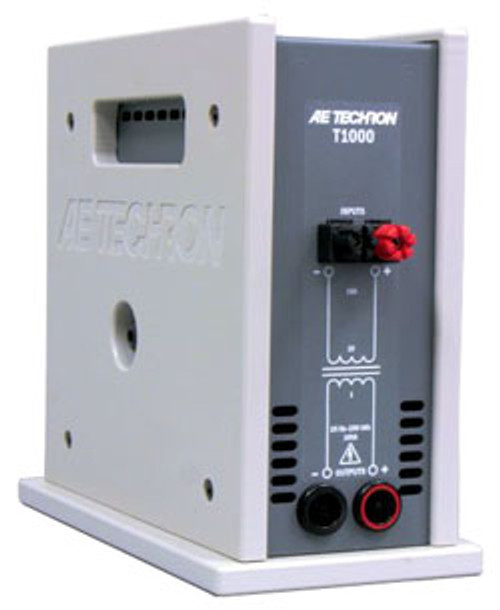AE Techron T2000 Overview
The T2000 Audio-Bandwidth Conducted Susceptibility Transformer was designed to meet or exceed the LF conducted susceptibility test requirements of DO 160 Section 18. The T2000 is used to apply the required test signals to the lines under test for ripple voltage tests and continuous or transient conducted immunity tests. It may also be used as a 2-to-1 step-down transformer. The secondary can support up to 40AP.
The T2000 transformer supports up to 200W and is able to pass up to 40AP on the secondary. The turns ratio provides a 2-to-1 step down.
The T2000 provides convenient input connectors via binding posts. Standard 0.75-inch spacing of binding posts allows use of standard plugs. Output is via Multi Contact 125A plugs.
A thermal breaker protects the unit against over-current conditions on the primary. A 35 ARMS breaker protects the unit against over-current conditions on the secondary. A rugged, impact-resistant case and robust design protects the transformer from accidental damage.
- Frequency response: 10 Hz to 250 kHz
- Up to 200W audio power
- Up to 40 Ap AC or DC secondary current
- Two-to-one step-down
- Output via Multi Contact 100A plugs; mating connectors include
Test Standards
- Chrysler CS-11809 (2009)
- DaimlerChrysler DC-1061
- DO 160 Section 16
- DO 160 Section 18
- Ford FMC 1278
- ISO 11452-10
- EMC-CS-2010JLR V1.1 (2011-01)
- MIL STD 461 CS 101
- MIL STD 461 CS 109
- MIL-STD-704
- Mitsubishi ES-X82115
- SAE J1113-2
- Tata TST/TS/WI/257
Controls and Connectors
Input Terminals: 4-way binding posts
Output Terminals: Multi Contact 125A plugs
Circuit Breaker: Secondary winding limited to 35 ARMS via circuit breaker; push to reset
Transformer DC Resistance:
Primary: 0.076 ohms
Secondary: 0.021 ohms
Frequency Response: 10 Hz to 250 kHz
Audio Power: 200W MAX
Dielectric Test: 1500 VDC primary to secondary
Turns Ratio: Two-to-one step down
Secondary Inductance: Approximately 0.6 mH (unloaded)
Protection: Input power-protected via thermal breaker; secondary winding protected via 35ARMS breaker















